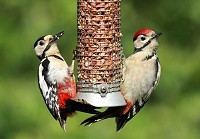Wildlife watching from the comfort of your own home
Most people assume that they have to travel to parks or nature reserves in order to see wildlife. Seasoned animal lovers know better. The latter know that their own back gardens can provide a wonderful opportunity for observing wildlife, giving them a front row seat to watch nature unfold on a daily basis.
Some of Britain’s most fascinating creatures often live in close proximity to humans and normally visit gardens to forage for food. The most common species one can encounter in gardens include hedgehogs, squirrels, rabbits, bats, birds, bees and butterflies. Some lucky people also get to see foxes and even deer in their gardens. Birds are especially famous for making gardens part of their habitat. House sparrows, wrens, starlings, blackbirds, blue and great tits, wood pigeons, chaffinches and collared doves are just some of the bird species gardeners can encounter.
The numbers of many of these animals are on the decline around the country and more people are taking the initiative to optimise their gardens to attract wildlife. These personal gardens act as perfect small conservation sites.
Optimising the garden for animal visitors
 Individuals who want to attract more wildlife into their gardens
may need to change a few things. Firstly, they need to ensure that they keep their gardens as natural as possible. They should also diversify the plant species to include a range of
flowers, herbs, shrubs and some
trees where possible.
Individuals who want to attract more wildlife into their gardens
may need to change a few things. Firstly, they need to ensure that they keep their gardens as natural as possible. They should also diversify the plant species to include a range of
flowers, herbs, shrubs and some
trees where possible.
Plants form the basis for most animal food chains and a diverse selection is sure to draw in varied wildlife. Be sure to include plants that attract bees and butterflies such as lavender, allium, cornflower, forget-me-not, catmint, Buddleia, blackberry, honesty, sweet william and many, many others.
Bird boxes and other shelters are useful additions to have in any garden, as are feeders and water features. The latter may include ponds, fountains or birdbaths depending on the available space and the owner’s preferences. It is also a good idea to scatter a few rocks or log piles around the garden to act as abodes for insects and bugs.
Other useful tips
Other than optimising their gardens, animal lovers should:
-
Educate themselves on the different wildlife species in their area. This will help them identify the animals and understand their behaviour, making animal watching a fun and educative process.
-
Pick a comfortable spot. Individuals who have small gardens can opt to watch wildlife whilst indoors to avoid startling the creatures. Custom fitted shutters can provide a good view of the gardens from the windows, allowing homeowners to watch animals without alarming them.
-
Interfere as little as possible. The goal of successful animal watching is to observe the creatures without interrupting their normal habits. Pets are best kept away from the gardens to avoid chasing or spooking the wildlife.
-
Remain still and silent. Once an individual has picked out a comfortable spot, they should remain as quiet as possible. Movement, loud sounds or bright lights can scare animals and drive them away.
-
Purchase suitable animal watching equipment. Binoculars and cameras are very handy for those who want to watch and document animals frolicking in their gardens.
This web site contains a record of all the wildlife I have seen in my garden in the last 10 years. Why not try it for yourself!





